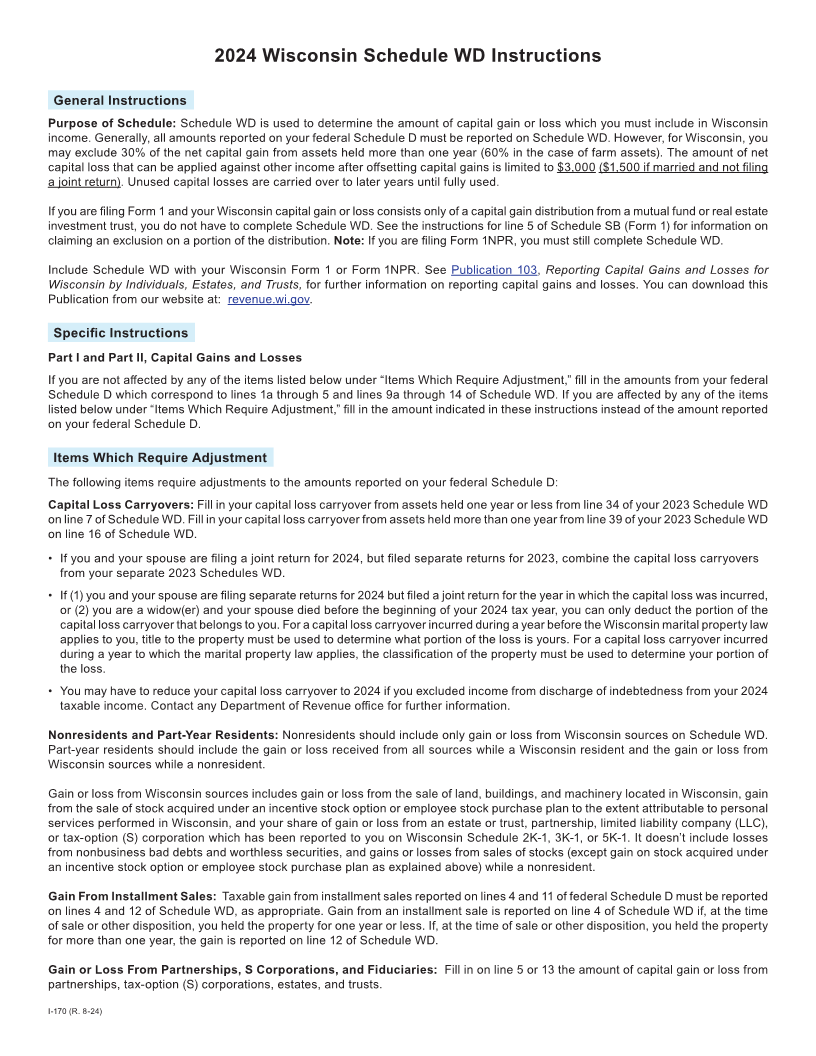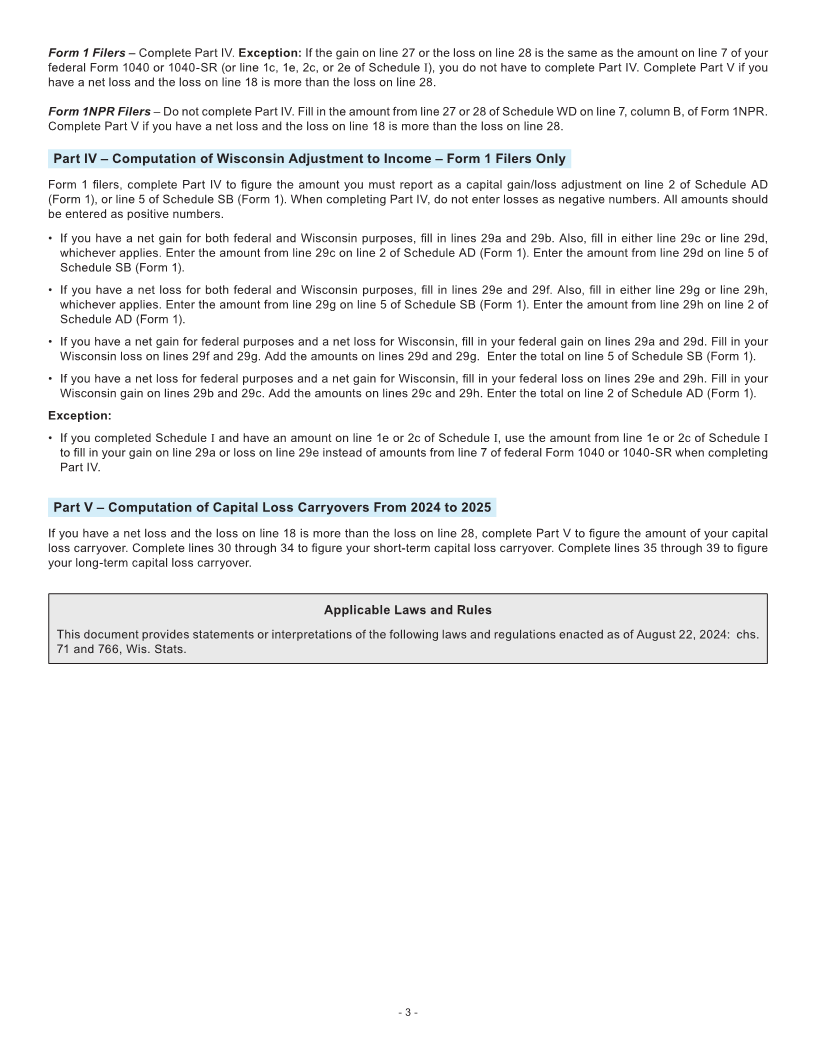
Enlarge image
2024 Wisconsin Schedule WD Instructions
General Instructions
Purpose of Schedule: Schedule WD is used to determine the amount of capital gain or loss which you must include in Wisconsin
income. Generally, all amounts reported on your federal Schedule D must be reported on Schedule WD. However, for Wisconsin, you
may exclude 30% of the net capital gain from assets held more than one year (60% in the case of farm assets). The amount of net
capital loss that can be applied against other income after offsetting capital gains is limited to $3,000 ($1,500 if married and not filing
a joint return). Unused capital losses are carried over to later years until fully used.
If you are filing Form 1 and your Wisconsin capital gain or loss consists only of a capital gain distribution from a mutual fund or real estate
investment trust, you do not have to complete Schedule WD. See the instructions for line 5 of Schedule SB (Form 1) for information on
claiming an exclusion on a portion of the distribution. Note: If you are filing Form 1NPR, you must still complete Schedule WD.
Include Schedule WD with your Wisconsin Form 1 or Form 1NPR. See Publication 103, Reporting Capital Gains and Losses for
Wisconsin by Individuals, Estates, and Trusts, for further information on reporting capital gains and losses. You can download this
Publication from our website at: revenue.wi.gov.
Specific Instructions
Part I and Part II, Capital Gains and Losses
If you are not affected by any of the items listed below under “Items Which Require Adjustment,” fill in the amounts from your federal
Schedule D which correspond to lines 1a through 5 and lines 9a through 14 of Schedule WD. If you are affected by any of the items
listed below under “Items Which Require Adjustment,” fill in the amount indicated in these instructions instead of the amount reported
on your federal Schedule D.
Items Which Require Adjustment
The following items require adjustments to the amounts reported on your federal Schedule D:
Capital Loss Carryovers: Fill in your capital loss carryover from assets held one year or less from line 34 of your 2023 Schedule WD
on line 7 of Schedule WD. Fill in your capital loss carryover from assets held more than one year from line 39 of your 2023 Schedule WD
on line 16 of Schedule WD.
• If you and your spouse are filing a joint return for 2024, but filed separate returns for 2023, combine the capital loss carryovers
from your separate 2023 Schedules WD.
• If (1) you and your spouse are filing separate returns for 2024 but filed a joint return for the year in which the capital loss was incurred,
or (2) you are a widow(er) and your spouse died before the beginning of your 2024 tax year, you can only deduct the portion of the
capital loss carryover that belongs to you. For a capital loss carryover incurred during a year before the Wisconsin marital property law
applies to you, title to the property must be used to determine what portion of the loss is yours. For a capital loss carryover incurred
during a year to which the marital property law applies, the classification of the property must be used to determine your portion of
the loss.
• You may have to reduce your capital loss carryover to 2024 if you excluded income from discharge of indebtedness from your 2024
taxable income. Contact any Department of Revenue office for further information.
Nonresidents and Part-Year Residents: Nonresidents should include only gain or loss from Wisconsin sources on Schedule WD.
Part-year residents should include the gain or loss received from all sources while a Wisconsin resident and the gain or loss from
Wisconsin sources while a nonresident.
Gain or loss from Wisconsin sources includes gain or loss from the sale of land, buildings, and machinery located in Wisconsin, gain
from the sale of stock acquired under an incentive stock option or employee stock purchase plan to the extent attributable to personal
services performed in Wisconsin, and your share of gain or loss from an estate or trust, partnership, limited liability company (LLC),
or tax-option (S) corporation which has been reported to you on Wisconsin Schedule 2K-1, 3K-1, or 5K-1. It doesn’t include losses
from nonbusiness bad debts and worthless securities, and gains or losses from sales of stocks (except gain on stock acquired under
an incentive stock option or employee stock purchase plan as explained above) while a nonresident.
Gain From Installment Sales: Taxable gain from installment sales reported on lines 4 and 11 of federal Schedule D must be reported
on lines 4 and 12 of Schedule WD, as appropriate. Gain from an installment sale is reported on line 4 of Schedule WD if, at the time
of sale or other disposition, you held the property for one year or less. If, at the time of sale or other disposition, you held the property
for more than one year, the gain is reported on line 12 of Schedule WD.
Gain or Loss From Partnerships, S Corporations, and Fiduciaries: Fill in on line 5 or 13 the amount of capital gain or loss from
partnerships, tax-option (S) corporations, estates, and trusts.
I-170 (R. 8-24)

